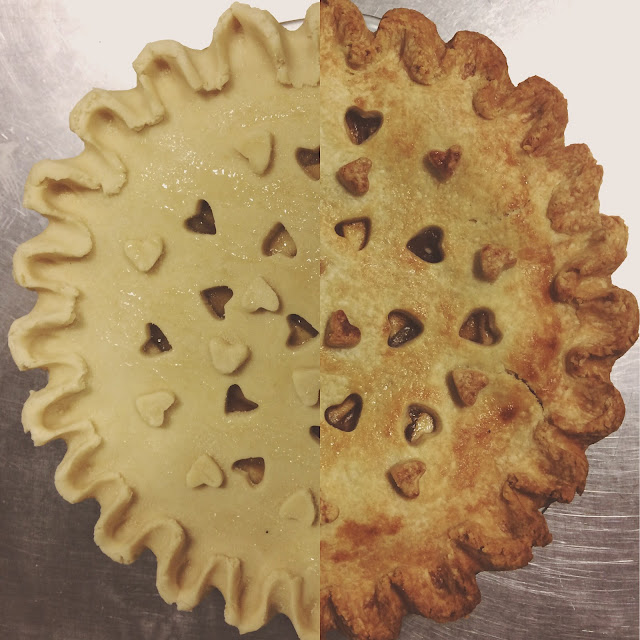Perfect Pie Crust (Double)
 |
| Before & after baking. |
 |
| Pies made at work for Thanksgivings gone by. |
Pie crust is something you're not usually immediately good at. Pie requires patience. I made my first fruit pie when I was in elementary school and have fashioned hundreds of pies (thousands?) ever since. I love pie because it signifies an important occasion or a person worth celebrating; pie generally isn't an everyday dessert.
I love adding a little baking powder to my pie crust because it makes the pastry a little more flakey and tender. I'm not sure-footed about too many things these days, but this pie crust is one thing I can depend on.
Double Pie Crust
Yield :: 8 serving double pie crust
Ingredients
- 2½ cups unbleached all-purpose flour or pastry flour
- ½ teaspoon salt
- 3 tablespoons organic sugar
- ¼ teaspoon baking powder
- 1 cup cold vegan butter
- ~6 tablespoons ice water
- 1 tablespoon apple cider vinegar
Procedure
- Combine flour, salt, sugar, and baking powder in a large mixing bowl.
- Cut vegan butter into small cubes using a knife or bench scraper. Add to bowl with dry ingredients.
- Using your fingers or a pastry cutter, rub the butter into the flour until evenly distributed and only small pieces of butter remain. You actually want to have small pieces (think pea-sized and smaller) of butter in the dough to promote flakiness, so try your best to not overwork the butter. If you have pie crust anxiety, I suggest watching this educational video provided by King Arthur Flour.
- Add a tablespoon of water and the vinegar and stir to combine. Continue adding a tablespoon of water at a time until the dough comes together appropriately. Be careful to not add too much water; adding too much water will make your dough less flakey and runs the risk of actually sticking to your pie plate. This is why after a few tablespoonfuls I like to work the dough with my hands: your fingers have better judgement than your eyes in this scenario. Once the dough just comes together and isn't sticky, that's when your dough is ready. On the flipside, if you add too much water or overwork the dough - no big deal. Like most things, pie dough only gets better with experience.
- Divide the dough in half and flatten into discs. Wrap each half tightly in plastic and refrigerate for at least 30 minutes or until you're ready to roll it out. Refrigerating is crucial to allowing the dough to chill and the gluten to rest. Remeber: a great pie crust requires some patience.
- When you're ready to assemble your pie, roll out the bottom crust either on a generously floured surface or on parchment with some flour. Pro tip: shape and roll the crust a little bit while it's still wrapped in plastic. The more your warm hands touch it, the more likely the crust may be overworked or get too soft. As you're rolling the crust with a rolling pin, pick up and rotate the crust 45 degrees as you go. Sprinkle flour on top and under the crust as you need it to prevent sticking. Try to roll your crust a little bit larger than your 9" pie plate so that there may be a little extra crust hanging over the sides. Once the dough is rolled, fit it to the bottom of your pie plate. Continue assembling the pie by making the filling and rolling out the top crust.


Comments
Post a Comment